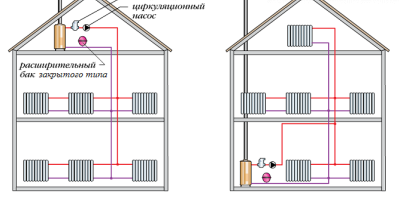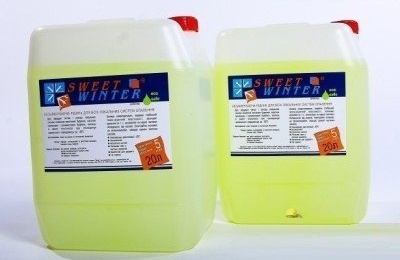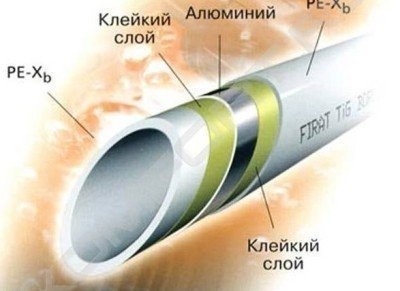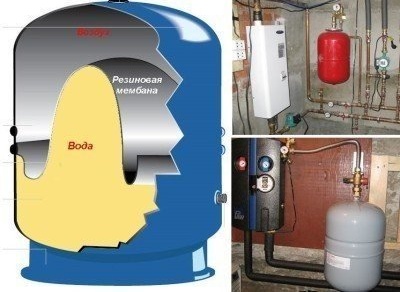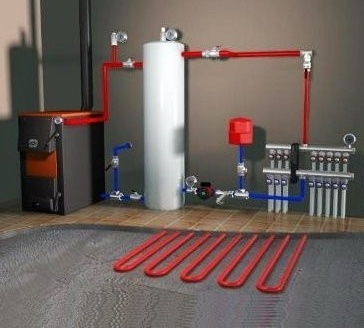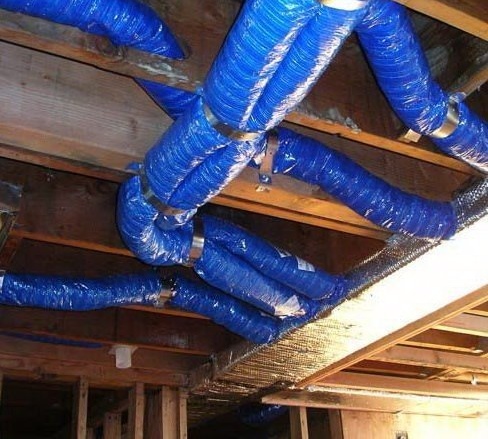Closed heating system: design features + equipment selection
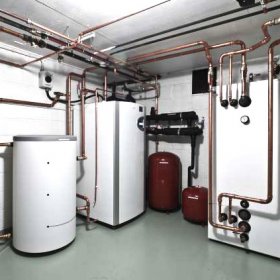
For a small country house, an open-type heating system is suitable, in which the coolant will circulate naturally, but for a building with a larger area, it is ineffective. The best option for a country house is a closed heating system, which has two differences. Firstly, the coolant moves forcibly - it is set in motion by the pump, and secondly, the expansion tank is closed (membrane).
Content
Components and principle of operation of such a system
The main elements of a closed system are:
- heating boiler;
- circulation pump;
- expansion membrane tank;
- heating radiators;
- pipes.
No less important are the connecting and auxiliary elements: filters, fittings, valves, valves, fasteners, taps. Consider the sequence of the entire system. To do this, you need a closed heating circuit.
In the boiler (1), the heat carrier is heated to a certain temperature, its volume increases and it enters through the pipes to the radiators (4) of heating. After passing through the return line (5), the excess coolant enters the expansion tank (6). The tank is a closed capsule divided into two chambers by a rubber membrane. A coolant passes through the first chamber, and nitrogen is under pressure in the second chamber. Before starting the equipment, the chamber with nitrogen is set to a pressure similar to the pressure of the system as a whole. Once in the tank, the heated fluid equalizes the pressure. The pump (9) serves to pump water, after which it flows back into the boiler.
For ease of use and monitoring the operation of the equipment, the closed-type heating system is equipped with a safety group (2) - for protection against overpressure, overpressure relief valve (3), valves (7), drain valve (8), pressure gauge (10), make-up valve (eleven).
First of all, the heating system must be provided with the required pressure. You will learn how to solve this problem from our following material:https://aquatech.tomathouse.com/en/voprosy/chem-sozdat-davlenie-v-sisteme-otopleniya-zakrytogo-tipa.html.
Design and operational features
On how the installation of a closed heating system is made, its further operation depends. Here are some tips:
- The pump and the expansion tank are recommended to be installed in the same room as the boiler. This will save money on the purchase of additional pipes, as the footage of the pipeline will decrease. Also, you do not need to position the pipes at an angle and increase their diameter. Therefore, the installation of system elements is greatly simplified.
- The membrane tank together with the pump is mounted on the return pipe, since when working with cold water the pump increases the service life.But there are a number of modern units that, after special lubrication, are excellently operated on the feed pipe.
- The water level does not need to be controlled, since it does not evaporate in a closed tank. Due to the tightness of the equipment, the system is also protected from airing.
- In practice, the closed heating system of a private house is perfect for large cottages, and even for industrial premises. In this, it also differs from the open-type system, which functions well only in small areas.
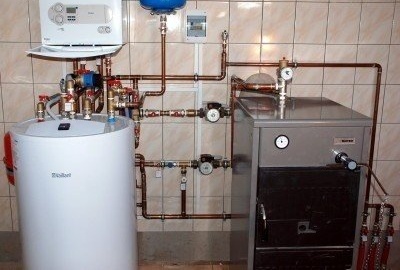
For the convenience of servicing equipment, the main elements are located in a separate room - a boiler room, or in the basement
Advantages and disadvantages of a closed system
A closed heating system has many advantages, here are some of them:
- coolant does not evaporate - provided that the sealing is correctly performed;
- large heat transfer;
- the lack of air in the pipes eliminates corrosion;
- the diameter of the pipes is smaller than in an open heating system;
- the service life of the boiler is increased due to a small difference in the temperature of the coolant at the inlet and at the outlet (provided that all system elements are correctly installed);
- You can use antifreeze, which will not freeze when the equipment is stopped in the cold season. In addition, it does not form scale and does not cause corrosion.
There are fewer disadvantages, but they should be taken into account during installation. The main condition for the operation of the equipment is the availability of electricity. If it is turned off, the coolant will cease to circulate. You should also pay attention to the volume of the expansion tank. It is 30-60% filled with coolant, and the smaller the percentage, the larger the tank in volume. If the system itself is large, then the tank should be installed quite voluminous.
If for a closed heating system an important condition is the availability of electricity, for an open - a constant gas supply. Read more about our article:https://aquatech.tomathouse.com/en/otoplenie/razvodka-otopitelnoj-sistemy/otkrytaya-sistema-otopleniya.html.
Selection of the right equipment parameters
In order to select the appropriate type and capacity of the boiler, the following factors must be considered:
- the area of the whole house;
- number of floors (take into account the basement and the attic, if heating is needed there);
- the quality of thermal insulation of rooms;
- Type of fuel.
If the insulation of the house is average and the ceiling height is about 3 m, 1 kW of boiler power is required for every 10 m². You should also calculate fuel consumption and stop at a more profitable option.
Radiators are steel, aluminum, cast iron. There is no fundamental difference between modern models, so you can choose those that are easy to transport and install - for example, panel steel radiators of a convenient height of 50 cm. The number depends on the area of the rooms, the presence of windows and doors. For example, for a kitchen with an area of 18 m², you need 2 radiators 60 cm long. It is recommended that the fasteners be installed directly under the windows to create a barrier to cold air from the street.
The choice of pipes depends on the type of system, since a closed single-pipe system needs a smaller footage. Experts recommend another option. They believe that a two-pipe system, in which two pipes are connected to each radiator, is more efficient. The best option is a horizontal bottom wiring of a sequential type.
They serve for a long time, are convenient to install and do not corrode metal-plastic pipes, a suitable diameter is 20-25 mm. To calculate the total length, you should measure the meter of the system as a whole, multiply by 2, add stock. Installation should start from the boiler, moving from a diameter of 25 mm to a diameter of 20 mm.Cranes are mounted on both sides of the boiler - for possible replacement or emergency. Nearby, on the feed pipe, a security group is installed.
For tightness, the joints are sealed with plumbing flax and special sealant using fittings. The most durable and resistant to pressure drops are bronze or brass fittings. Before the pump, it is necessary to install a filter and equip it with two taps - for cleaning.
Pump performance depends on the area of the house and the diameter of the pipes. Suppose, with a building area of 250 m², the productivity is 30 l / min (pipe diameter 25 mm).
To protect against an emergency power outage, you should purchase a UPS. 700 W uninterruptible power supply will ensure system operation within 12 hours after shutdown.
The volume of the expansion tank depends on the total volume of the system. If the total volume of the system is 450 liters, you should choose a tank with a small margin, that is 35 liters.
In the future, it is possible to increase the system due to the heating floor equipment. To do this, you need to connect an additional branch of the pipeline, providing it with a separate pump.
You can make a combined heating system with radiators and underfloor heating yourself. In our next article you will find a detailed installation guide:https://aquatech.tomathouse.com/en/otoplenie/razvodka-otopitelnoj-sistemy/radiatory-plyus-teplyj-pol.html.
Schemes of various heating systems are presented in the video below:
